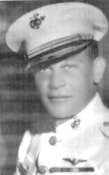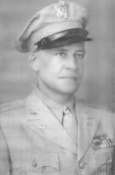

1898-1943 |
 |
 |
Collection of Ed Schultz, Jr. |
Collection of Ed Schultz, Jr. |
|
Much Interest Manifest In Creation of Reserve Group Here South Dade Advertiser, May 10, 1935 There are already several young men in the district who are attached to Miami platoons, and at least 40 others are interested. Capt. Ed. Schultz, commanding officer of the Marine Scouting Squadron at Opa Locka, Mayor Tom J. Harris, W. J. Geronimo, and other South Dade service men are taking the lead in establishing the unit which will be sponsored by the John G. Salley Post, America Legion. Announcemnt of a meeting to which all men over 17 years of age will be invited at thiwch time details, requirements and advantages of the unit will be explained, will be made in the near future, Capt. Schultz said. Official motion pictures of Marine and Naval aircraft activities will be shown. Requirements for enlistment will be explained as well as a detailed explanation of the classes in engines, aircraft............. This clipping was provided by Ed. Schultz, Jr. - August, 2002 He estimated the source and the date of publication |
|
The Maryville Daily Forum August 14, 1942. Courtesy of Ed. Schultz, Jr. After his separation from the Marines he trained pilots as an instructor in the Civilian Pilot Training Program, the first program at U. Georgia, Athens, and finally at State Teachers College, Maryville, MO, now named Northwest Missouri State University. He re-entered the service at the outbreak of WW2 as a Major in the USAAF. On hearing of the sneak-attack on Pearl Harbor, in his anger at the Japs he asked to be returned to the Marine Corps, but was told that he was too old, and that his proper place was training pilots. During his extensive aviation and military career he had made many highly placed friends in the military and political arenas. As a result he was commissioned as a Major in the USAAF. After his re-entry into the military he flew with the Transport Service, but called in favors and demanded to be assigned to combat units, in which he performed with a vengeance. He wound up as Tactical Executive Officer of the 308th Bombardment Group. He was killed in action on 29 July, 1943 at Yangkai, China, while returning from a successful bombing raid at the Hong Kong dockyards. His pet unit, the 373rd Bomb Squadron's B-24 Liberator had run out of fuel because of increased drag caused by a new retractable turret they were testing, and the crew was ordered to bail out. A Chinese Air Force observer, 1st Lt. Hsu Tung Chow accidentally spilled his chute inside the aircraft and (then USAAF) Major Schultz and Capt. William Chenoweth, the other pilot, in an effort to save Lt. Chow from certain death, elected to dead-stick the plane into a rice paddy. The aircraft could not shed speed quickly enough and hit a berm, killing all three officers. The remainder of the crew had bailed out safely. |
|
|
|
by Michael Schultz |
|
Letter to Richard Sherman from Dave Schultz Sir: No language has words effective enough to express the level of my appreciation for your kindness in sending that article from "Flying Aces" to my wife, Sandy. As you probably gathered from speaking with her, she's one in ten million. It was her tenacity that resulted in finally locating you and your (to us) priceless copy. That same tenacity has held us together for forty years, now. I wonder how many fond memories that account brought back to you. It was a delight for me both for the thrill of the images that were evoked and pride in my Dad. Corny in places, yes, especially by today's standards; but clearly perfect for the time and what the 'un-chosen' ground-bound masses expected. It also reiterated the old Marine Corps adage: "Flying is like making love and you can do it longer." (Or words to that effect). The reason for my excitement is simple: I never knew my father, and have until only recently gained little information beyond the super-hero image my mother painted of him. He went off to war when I was two. Bottom-line summary of his life: he died during WWII, in an attempt to save another man's life. To me, that says volumes, but if you're interested in a synopsis of what we've learned over the last couple of years, read on. You may read the whole story by clicking on the title above. |
|
Ed Schultz's youngest brother, Dave, a former U.S. Marine Aviator and Viet Nam veteran, passed
away Jan. 24 of this year, 2007. He followed in the footsteps of Ed Schultz,. Sr., who was one of the first pilots hired to fly for the original Pan American Airways in 1927. The senior Schultz flew the old Fokker Tri-motors and Sikorsky seaplanes several times with Charles Lindberg in the Carbbean/S. American sectors. He was KIA in WW2 with the USAAF in China. |
|
by Lieut. Edward G. Schultz, U.S.M.C.* |
 |
|
"There she lies, eager for the air. What a job! A fighter - a single-seated fighter and a sweet crate.
Polished and shined until she gleams all over. Strength in every line of her. Strength and promise. The sweep of her wing is perfect, and
her full-bodied fuselage is streamlined from nose to tail. Buckling on your 'chute, you walk over to her. A little tap on her taut wings - they vibrate. A slow look at all of her, as your hand rests gently, almost caressingly, on the fabric. She seems to be looking askance at you, as if saying to herself: - Has this guy got it, or is he just going to take me up and mess around the sky?- Through your fingers on her fabric, you can feel her say: - "Treat me right, feller; don't go loose on the controls just when I need you most, and don't get sloppy and skiddy. For when I dive, I dive; when I spin, I spin; and heaven help the bird who fails me." You sort of say to her - "Stick around, baby, because I'll be with you when you spin and I'll be with you when you dive. But don't you go busting any control wires." Into the cockpit you go, wiggling some to get the 'chute comfortable. A couple of shots with the primer, the switch is on, and you press the starter button for a few seconds. It picks up with a crescendo whine, so you give it throttle. After a couple of protesting barks the engine takes. The oil pressure pops up but the heat is low, 80 you reach down, close her shutters, and open the bypass. As the heat builds up, you feed more throttle until she's rolling a thousand. And there you let her set until some real temperature shows. She's alive now - hands fluttering on the instrument board, wires vibrating. And there begins to be a feel on the flippers and rudder. You juggle them a little just to see if they're functioning right. The heat is up now. You open the gun all the way to the supercharger stop and try the magnetos."........... This excerpt is taken from the complete article which is found in the January, 1936 issue of "Flying Aces" Magazine. The copy was very kindly furnished by R.J. "Dick" Sherman, (Also a WWII Marine Corps Aviator). To read the whole story, click on the title above. *Lieut. Edward Schultz is a chief pilot with Pan-American. He's made a splendid record hopping fighters - so when you go through this test flight, you'll get the real thing! |
|
via email from Ed Schultz, Jr., 10-29-05 Well, after 69+ years, this ol' grunt Marine finally soloed an airplane. Last Thursday, Oct. 27, at Stafford (VA) Airport my CFI jumped out on the taxiway and said "I need a break. Gimme three full stop takeoffs & landings and come inside for a cuppa coffee if yer still in one piece." Piece of cake!! I've been an A&P Mech for a bunch of years and all my pilot buddies back at Hyde Field(MD) wanted to know if I was nervous. Nope, I was nervous before my first parachute jump 24 years ago, but now, just a little anxious by myself in the plane. Most of all, just pissed off all the time because the government has put all the restrictions on the three small General Aviation airports, (Hyde, Potomac & College Park are FRZ), which are inside a 15 mile radius from Wash., DC, and an ADIZ out to 35 miles around DC, all the while keeping visible by transponder to ATC and being in radio contact w/ controllers. Having to travel or fly so far to practice is a hardship on the patience and pocketbook, especially since that same gov't won't reel in the oil companies on the gas prices. Anyway, I imagine my dad, Maj. Ed Schultz, Sr., who was KIA 29July43 near Yankai in B24 Frendlin, 373BS, was looking down and saying, "It's about time, 'Pistol'." :-) Best to all, Ed Schultz, Jr. OCH #312 |
|
|
|
To read the story, first click on the title above to go to the site. Next click on "Stories" and then on "Fate of 'FLAMINGO and FRIENDLIN" I highly recommend that you visit this site and enjoy this glimpse into an exciting event in the war. |
|
If you have any information on this pioneer aviator please contact me. E-mail to Ralph Cooper Back 
 |